Opening up the top of your funnel is one of the most effective strategies you have for building an audience for your brand. And that’s exactly what ToFu content does—it’s top of the funnel content designed to attract the most interested and engaged website visitors you can.
But, like the ubiquitous bean curd that shares its name, ToFu content is hard to do well. Miss the mark even a little bit, and you end up with a bouncy mess that drives your website visitors to seek out something with more substance.
While not as conversion-focused as the content you create for readers who are further down the marketing funnel, a good mix of ToFu content can set the right expectation for people who are just starting their relationship with your brand. You can even drive down acquisition costs by tailoring your ToFu content to appeal to a more specific and engaged audience.
Understand how much ToFu content you need to create, the ways it supports other areas of the content funnel, and best practices for incorporating it into your marketing strategy, and you’re setting the stage for a smoother conversion path as customers move closer to making a purchase.
Understanding the Content Funnel
To gain a better understanding of ToFu content, you first need to understand where it fits into your content funnel. Situated above MoFu (middle of the funnel) and BoFu (bottom of the funnel) content, ToFu content is your first impression—it helps target potentially interested customers as they’re introduced to your brand.
As your potential customers move through the acquisition funnel, they naturally move closer to an eventual purchase decision. When your ToFu content is doing its job, the people who enter your funnel are already primed and interested in learning more about the product.

Think about ToFu content as a tool for not only building brand awareness but also awareness of the problem your product or service solves. Do it well, and ToFu content helps you appeal to the right people at the beginning of their search buyer’s journey. It’s always easier to convert someone who’s actively interested in the solutions you provide.
ToFu Content
ToFu content is your foot in the door—it’s designed to help you introduce your brand and start building a relationship with website visitors who could eventually become customers. The wider the top of your funnel is, the more potential audience you have to convert with MoFu and BoFu content.
Your keyword targeting strategy at this point should focus on high volume as the core decision metric. You don’t have to be product-specific at this point, either; it’s purely about finding the long-tail variations that are relevant to your business and attractive to potential customers.
Let’s say you’ve built a brand-new unified workspace or project management tool. One example keyword to target could be how to stay focused at work.
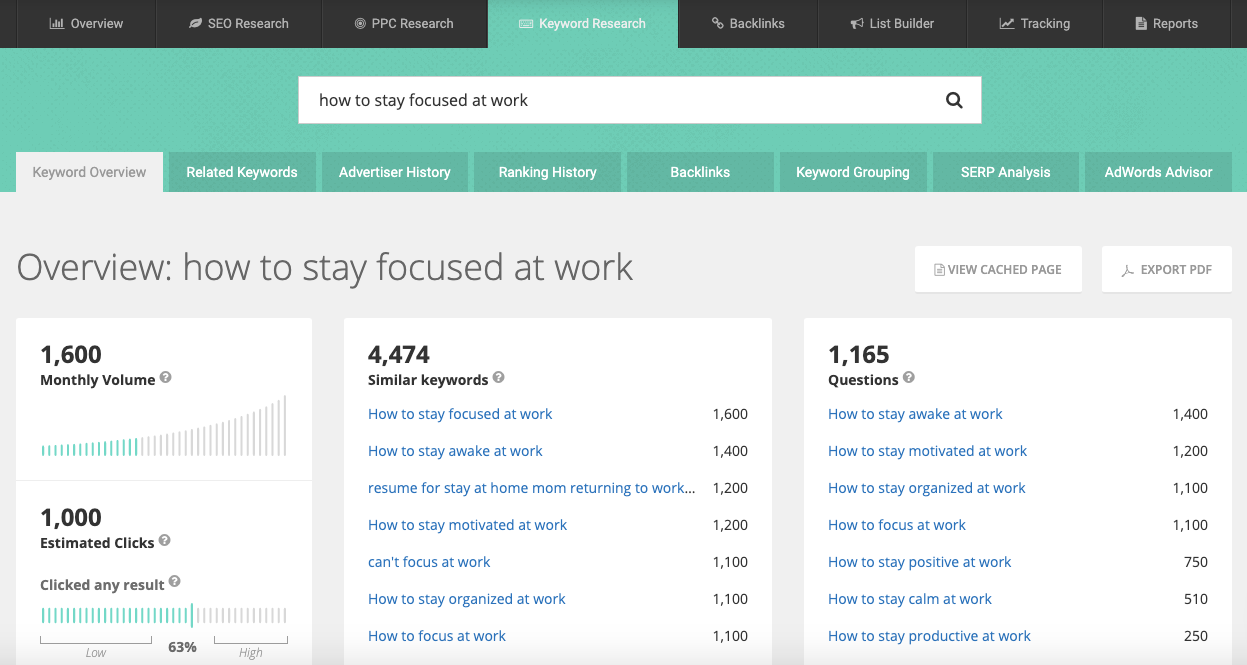
With a monthly volume of 1,600, there’s a fair amount of search traffic to capture by ranking well, and it’s relevant to the functionality of our example product without being specific to the product itself. The keyword also lends itself to some great content ideas.
Some articles you could create are:
- The Project Manager’s Guide on How to Stay Focused at Work
- 10 Strategies for Staying Focused at Work
The themes you go over in these articles can help provide value to your readers while also priming them for more specific information about the product further along the funnel.
MoFu Content
MoFu content is all about building trust and credibility with your audience. The potential customers you’re targeting are moving into the consideration stage of the acquisition funnel, so your goal is to sway their opinions in your favor.
Targeting at this point should be focused on competitive keywords that are more closely related to your product than those you go after for ToFu content. MoFu content is your chance to showcase the differentiable value your product or service provides. Potential customers have already been introduced to your brand via ToFu content, so it’s time to think about how to convince them that what your company has to offer is the best.
Building off our unified workspace/project management tool example from earlier, some keywords to target at this stage of the funnel would be project management framework or workflow management.

Monthly volume here is less than our ToFu keyword, but the intent matches up with people who are searching for project management-related information. You’ll be able to use this keyword to create an article that speaks directly to a business need of target customers—understanding how project management frameworks are applied to everyday tasks and workflow management.
Some articles you could create are:
- 5 Top Project Management Frameworks to Guide Your Team
- Finding the Right Project Management Framework for Every Task
Your MoFu content should work towards educating potential customers on the value that your tool provides and the subject matter expertise your company has to offer. It’s all about building on the relationship that was formed through ToFu articles and cementing your place as the best resource to find information that’s relevant to customers’ needs.
BoFu Content
With BoFu content, we’ve reached the very bottom of your acquisition funnel—the content you create here should be 100% conversion-focused. Your audience is ready to make a decision on the product or service that’s best suited for their needs, and now’s your time to close the deal. The bottom of the funnel is all about showing that you can solve a real and meaningful problem for the customer.
Keyword targeting at this stage will likely be the most competitive you experience—everyone is vying for potential customers to choose their service over yours. While volume is still an important factor in the keywords you choose, it’s more about finding the most relevant keywords available. Branded and product-specific keywords should be a part of the strategy at this point as well.
Since we’re using the project management space in our example, targeting keywords like project management tools or [competitor] alternatives is a great place to start.
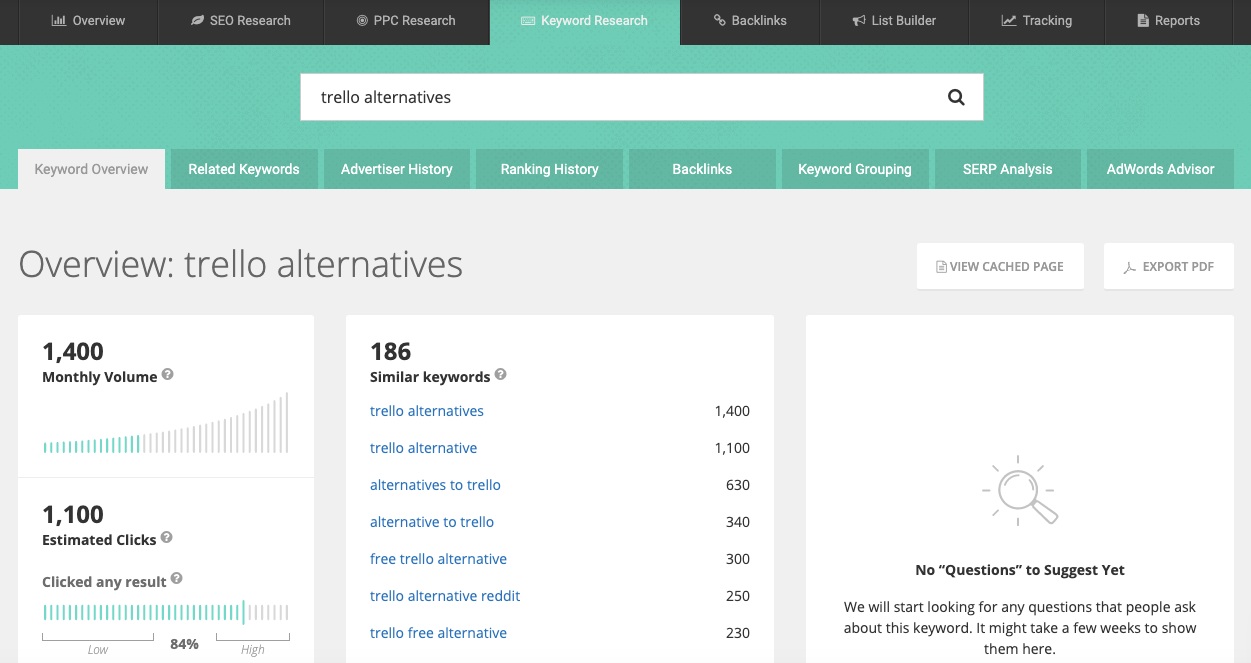
The competitor keywords can actually provide a fair amount of volume as well as great intent. Whether someone is searching for alternatives to their current tool or just knows Trello as a leader in the space, this keyword targets searchers who are well along the acquisition funnel towards making a decision.
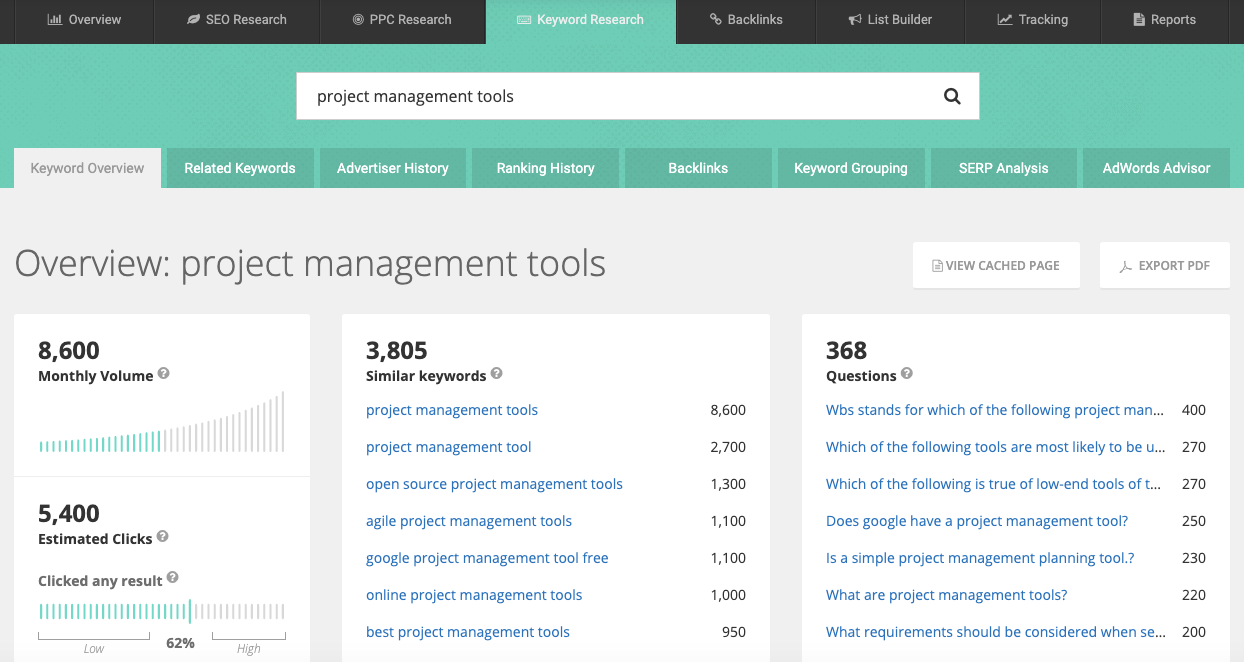
The same can be said for project management tools; the searchers for this keyword are actively looking for a tool to help solve a problem their team is having.
A few articles to create would be:
- The One Project Management Tool to Rule Them All
- Trello Alternatives: How to Level Up Your Kanban Boards
Your BoFu content will be the most outspoken you create, focusing intently on the value your product or service provides as well as its advantages over the competition.Understanding where your articles fit into the content funnel is the first step towards creating a more well-rounded marketing strategy. Each content type fits into the funnel and provides value for different kinds of website visitors.
How to Use ToFu Content in Your Content Strategy
Determining when to create more ToFu content requires a solid understanding of how your marketing funnel is currently performing. Take a look at your blog’s performance and see how much organic traffic is coming in. If your audience is dwindling or you’re seeing a higher-than-average bounce rate on existing ToFu articles, it’s probably time to create more.
Just remember that ToFu content doesn’t drive conversions in the same way as MoFu or BoFu content. The only goal is to bring in more interested website visitors, so they get introduced to your site.
That’s why looking into metrics like bounce rate is so important. When someone bounces from a ToFu article, that likely means you’re not providing the level of value they expected when clicking the link in the SERP. Successful ToFu content draws readers deeper into your blog and provides them with the incentive to learn more.
If you’re really interested in seeing how specific ToFu content performs, check out the entrances for it to see how many readers start their session at that point. Here’s an example from our very own blog:
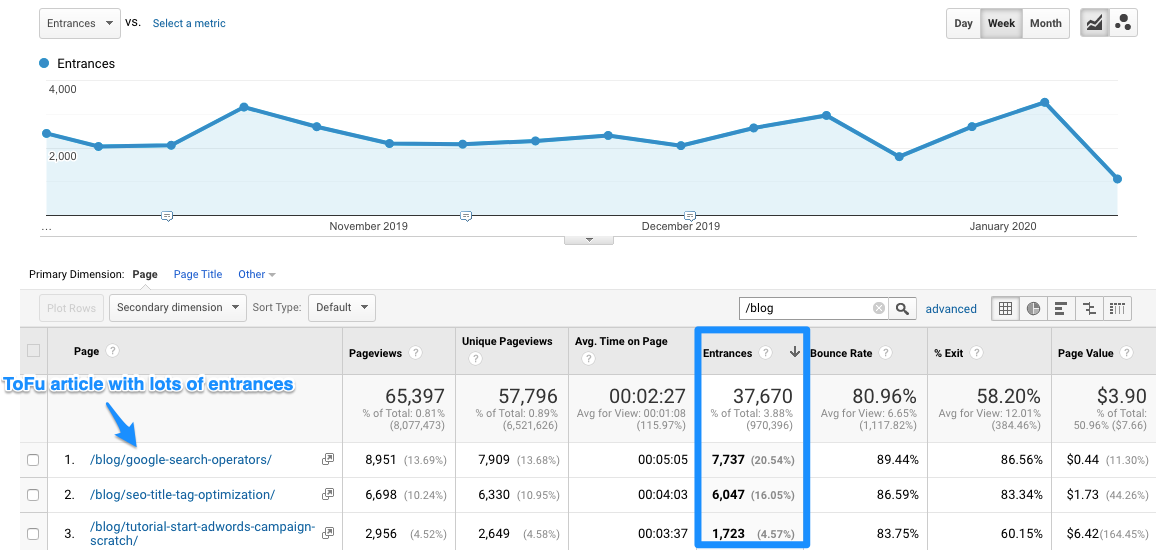
This article consistently brings in the most entrances on our blog, which makes sense as it is a ToFu article. While search operators are relevant to our readers, they’re not directly related to our product. We’re using the article as a way to attract SEO marketers and visitors who are interested in learning more about how to search better on Google.
The effective use of search operators is a great skill to have when you’re performing SEO and keyword research, so we’re speaking to people who potentially have a need for the type of service SpyFu provides. It also works to build our subject matter expertise in all things search and positions the brand as a helpful and knowledgeable resource.
Another situation where ToFu content can be more valuable is when you’re entering a new market or releasing a new feature. In these circumstances, your company won’t have the brand equity as one of your more established competitors, so getting your name out there is vitally important.
With all that said, ToFu articles are still just the introduction. In order to build an effective content funnel, you need to hook website visitors’ attention with high-level articles and slowly introduce more product-specific and conversion-focused articles to move people along their journey. That’s why a well-rounded content strategy is so important; the different content types you create support one another as customers move closer to making a purchase.
A Blended Approach Is Your Best Option
Great content marketing and SEO strategies have a solid mix of all the three content types we’ve discussed today. Finding the right balance of ToFu, MoFu, and BoFu articles will guide potential customers closer to making their purchasing decision by providing different types of value at each stage of the process. If your blog skews too far in either direction, you make it really difficult for potential customers to buy into a relationship with your brand.
Having a disengaged audience isn’t just bad news for your conversion-focused content, either. Attracting website visitors who aren’t interested in eventually purchasing your product will lead to higher bounce rates that can drive down your ranking. Search engines are built to surface relevant and engaging content that people actually want to read.
As one of the most important ranking factors, according to a 2019 SparkToro study, failing to deliver on relevance will tank your rankings over time.
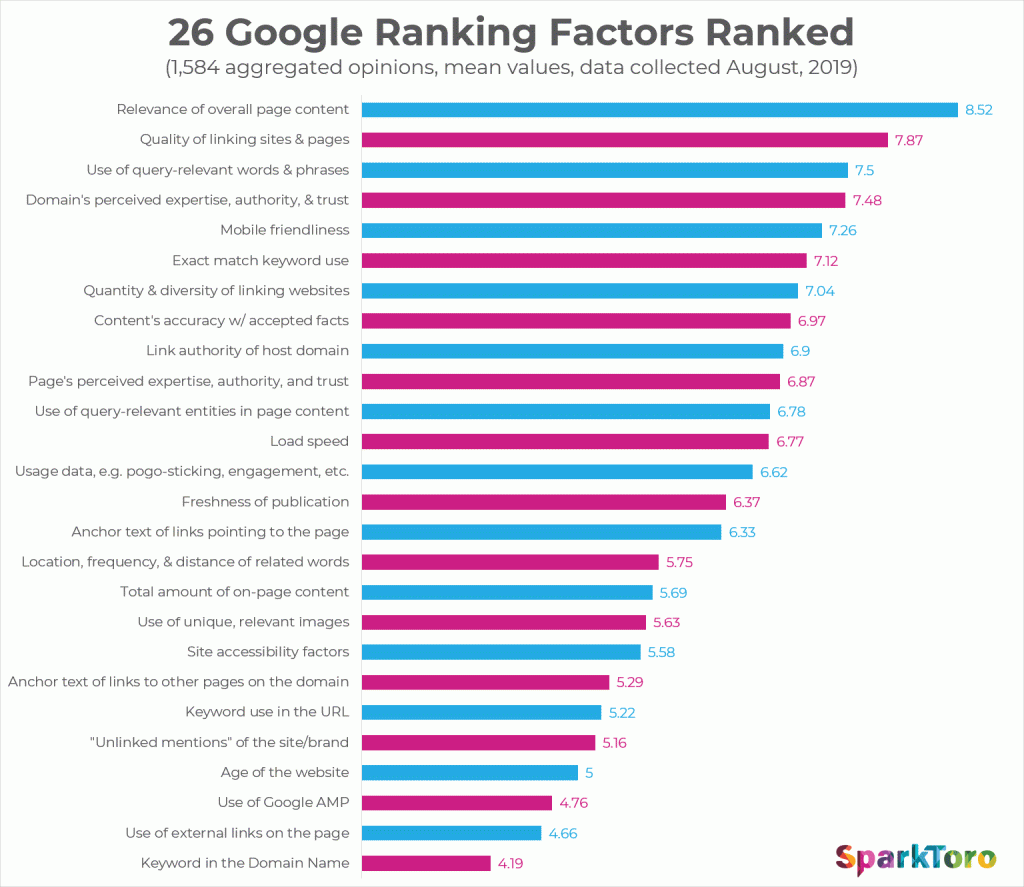
It’s important to consider how each of these factors informs the content you create for different stages of the funnel. While ToFu content may be less focused on product relevance, it still needs to be relevant to your audience.
If you’re just getting started with building out the different kinds of content that make up your content funnel, it’s important to consider where your company is in terms of its growth and market conditions as well.
- New companies trying to get a foothold in an established market will need to create more ToFu content than their competitors just to get their brand name into the conversation.
- More established businesses can focus on MoFu and BoFu content to further develop their existing relationships with their audience and move them closer towards eventual conversion.
One of the best things you can do is tailor the content you create to your understanding of how customers make decisions. That’s what makes buyer personas so important; a data-informed mock-up of your target customers helps you write content that’s focused on their unique needs at every stage of the funnel.
From a keyword perspective, consider how each piece of content you create solves a real problem for the reader. What kind of information is most valuable at different stages of the funnel.
- ToFu: Broad keywords that are relevant to your brand and industry
- MoFu: More specific keywords that are relevant to your product and the problem potential customers have
- BoFu: Product- and solution-focused keywords that convert people into customers
When you’re writing ToFu content, it’s likely going to be tailored to solidifying where your brand sits in the market and the tools you provide. The MoFu content goes into more product-focused keywords and long-tail variations, building out a hub of information that builds on the ToFu content that brought people to your site in the first place.
With those two stages set, the BoFu articles you create don’t have to do as much work to explain your place in the market. The aim is to convince your potential buyer that your product or service is the best choice.
When you consider how each piece of content fits together with the entire funnel as a whole, visualizing how each article contributes to a potential customer’s movement towards an eventual purchase is simple. Take a blended approach and build your content in a way that not only supports your customers but your content marketing goals as well.
ToFu Content Opens Up Your Marketing Funnel
The goal of ToFu content is to bring as many relevant and interested parties to your website as possible. Once there, you can use MoFu and BoFu content to move potential customers closer to conversion by building brand affinity, trust, and credibility.
Getting ToFu content right ensures that you’re setting the stage for potential customers to buy into your product’s value and actually make a purchase further down the line.

